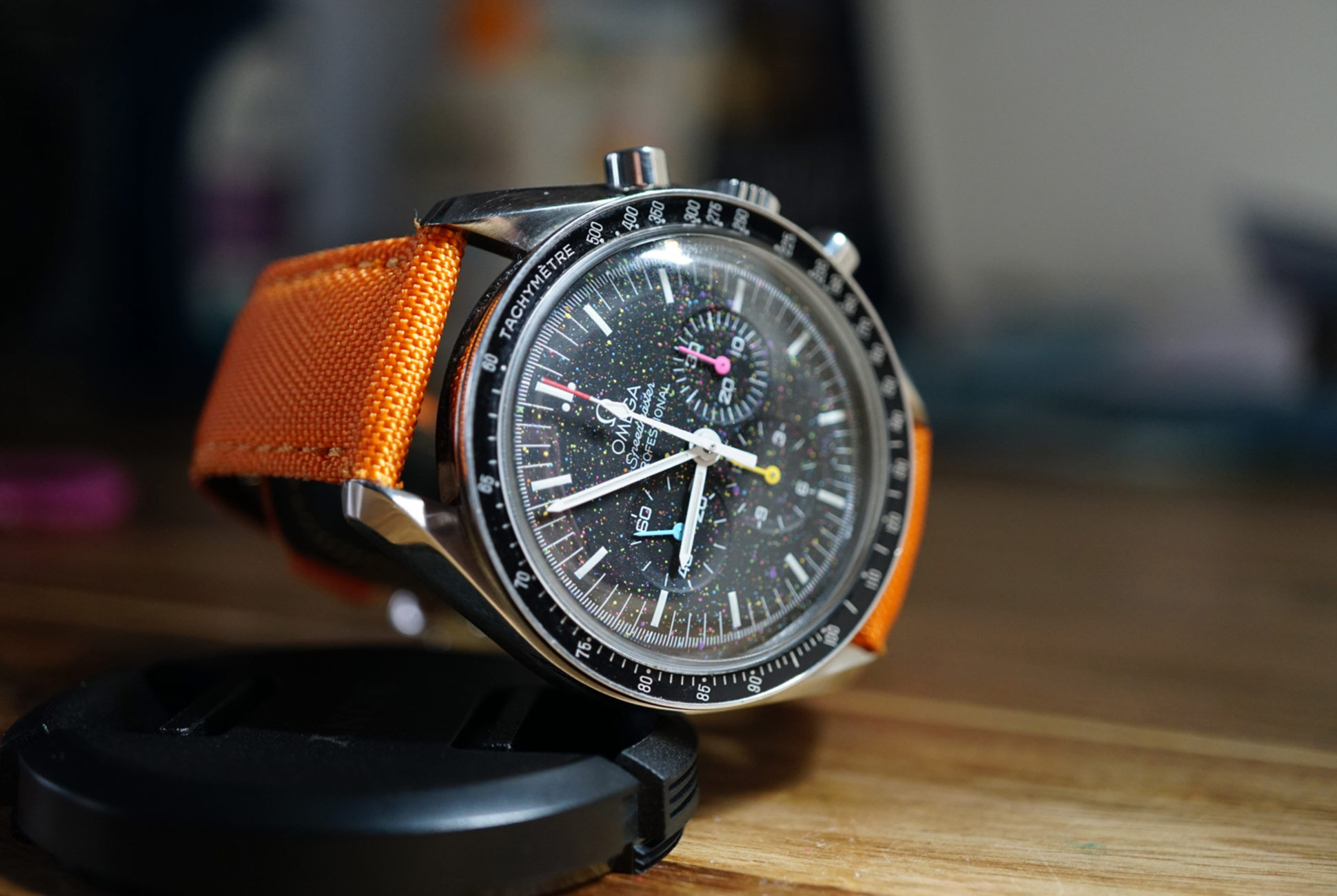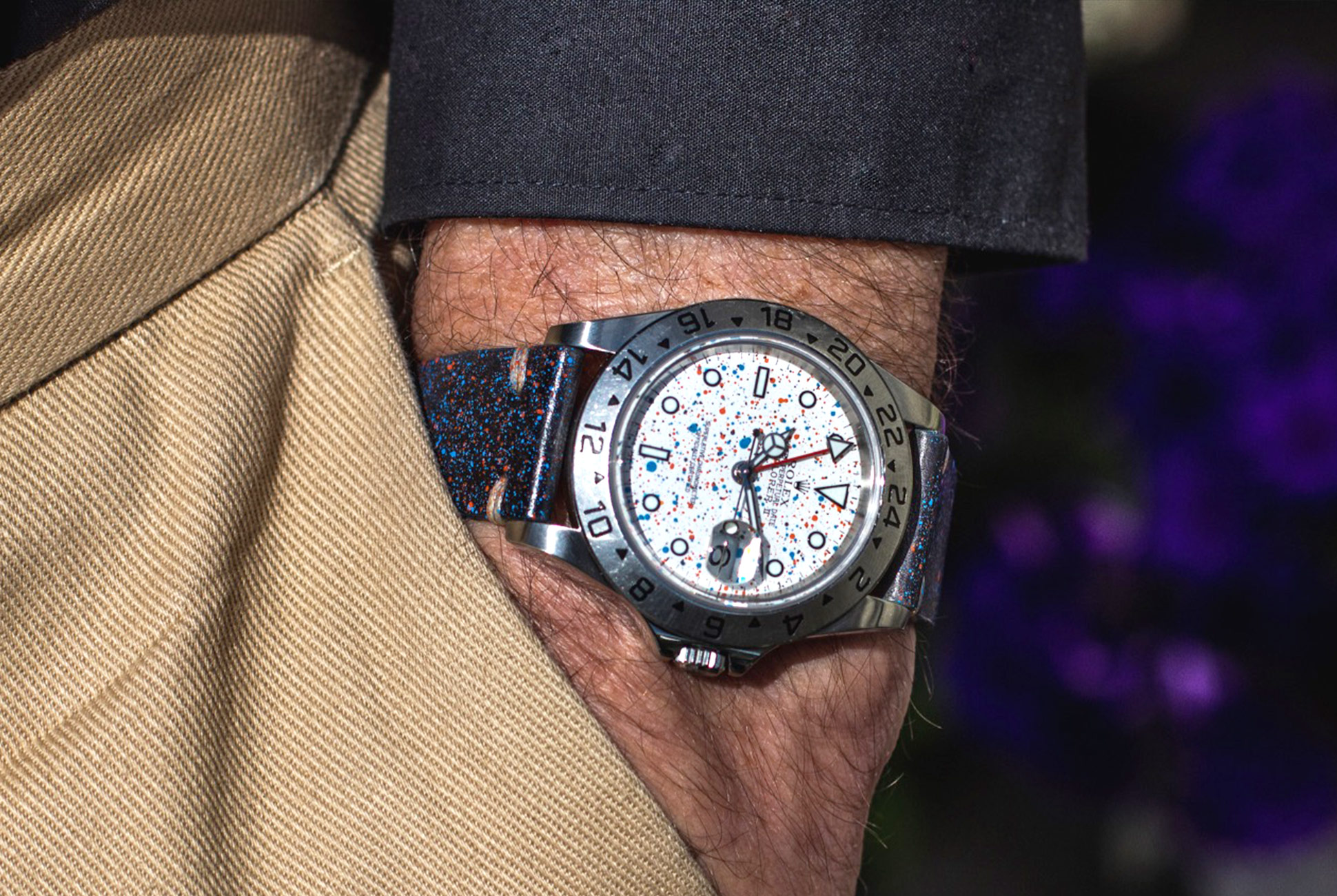C
hris Alexander’s work is divisive, to say the least. If you’re a detractor, you probably cringe upon seeing a Rolex or Omega dial spattered in colorful paint. If you’re a fan, you dig the vivid, almost iconoclastic nature of his work. It’s a fact he’s well aware of and embraces: “That’s the point of art…it’s in the eye of the beholder,” he tells me.
No matter what your stance, though, there’s no doubting that Alexander’s work stands out in the Instagram watch world. His account, Creo Watch Designs, is stuffed with Seikos, Rolexes, Omegas and other watches, marked with eye-popping, Pollock-like paint jobs that are unlike anything you’ll find anywhere else. Literally: each watch is hand-painted, one-of-a-kind and much of Alexander’s work is done on a commission basis to the specs of the client. A single dial can take hours, even days or weeks to complete, according to Alexander. I spoke with him over the phone to learn more about his passion for watches, his artistic inspiration and his process.

Vero eos et accusamus et iusto odio dignissimos ducimus qui blanditiis praesentium voluptatum deleniti atque corrupti quos dolores et quas molesti Photo by John Doe.
Q:
How’d you develop an interest in watches?
A:
I think it started when I was about four or five, and my dad had quite an interest in mechanical watches and had acquired watches and parts and that spurred me into exploring that a wee bit further. He bought me my first mechanical — well it wasn’t mechanical, it was kinetic, a Seiko Kinetic watch — when I was about ten. That started me off in understanding watches to a certain point and appreciating timekeeping. I’ll be honest in saying later in my life that interest kind of died down, when you start to get more interested in things like motorbikes and all sorts of things, but in recent years it’s been kind of reignited as there’s been growing awareness of mechanical watches. So it’s come full circle
Q:
How’d you start painting watch dials?
A:
It started a few years ago when I had a Seiko SRP777, if I can remember right — a Turtle. And I was just looking at it one day, and I was like “you know what, how can I use my skills in being a creative person to add a wee bit of personality to the watch.” And you know I wasn’t a watchmaker or didn’t know the ins and outs of a movement, but there are plenty of forums and resources out there about how you can open up a watch and take things apart, so I thought well, I’ll paint the dial and see what happens. Then on an online forum, I shared a photo of my watch and people loved it and wanted to know what I was doing and how you get something like that. So that kind of very quickly spiraled from that sort of obligatory post into what I’m doing today. It sort of went from zero to a thousand very quickly, but it’s been very exciting.
Q:
How would you describe your aesthetic and how did it come to be? Is there any specific inspiration behind the design language?
A:
I would say it’s modern abstract. You know, Jackson Pollock is an obvious individual whose work I take a lot of inspiration from. His work is well-recognized — it’s incredible stuff. There’s not a lot else I would say I’m trying to emulate. I’m not really even trying to emulate him, but I think that sort of abstract, organic look is what I’m trying to achieve with my work.

Q:
If somebody commissions a work with you, what’s that process like in designing the dial?
A:
My first question is “What do you want and what do you want it to be on?” Every watch sort of already has its own personality built into the dial and the case, some designs will naturally translate to a different style of watch, so I try to understand what they’re thinking of doing. I try to ask questions along the lines of, “What will you be using it for? Do you want it to be loud and in your face, or do you want it to be subtle?” So really I try to make it quite a collaborative process with the client, rather than just have them go “Here it is, do something.” I’m quite happy to sit and chat with somebody for a long period of time about what I think we can do and what it might look like.
It’s through that collaborative process we talk about if there’s anything that inspires them through colors, then people send me images they like, and I can extract colors from that, though some are really happy to have me do what I think is right. Everyone comes with their different take on it and like I said, depending on the watch and what they’re thinking of doing, that gives you the creative path to doing what you think might be best. And I try to make samples for them to give them ideas, and that solidifies the design, then we crack on and do the work on the watch itself.
Q:
So what’s the painting process like?
A:
Once we have confirmed color and styles and the client has a better idea of what to expect, when we do get the watch there’s quite a lot of prep work that’s involved depending on whether or not they want lume left in place, or the numbers protected or the logo. So there’s lots of preparation that goes into protecting those parts of the watch. There’s a lot of preparation involved to make sure that whatever I paint is what I should paint, and that I don’t paint anything I shouldn’t.
And then it’s really just a free-hand style, and I paint it individually. It can sometimes take several hours. Sometimes when I’m painting more realistic stuff, that takes days up to weeks. The paint has to be very flat, and it has to be highly UV-resistant. You can’t just gloop on paint because that’ll stop the hands moving. So it is a very laborious process to some extent, but I think the results speak for themselves.

Vero eos et accusamus et iusto odio dignissimos ducimus qui blanditiis praesentium voluptatum deleniti atque corrupti quos dolores et quas molesti Photo by John Doe.
Q:
What’s the most interesting watch project you’ve ever worked on?
A:
I did a painting of a turtle on a Seiko Turtle, and I found it interesting because it was the first time I sat down and tried to paint more of a contemporary art piece rather than an abstract art piece. There are a lot of learning curves involved. And then I had somebody else ask to do a whale versus a squid, and that was a project that required a lot of to-and-fro with design and placement and what should we do here and what should we do there. So that was quite a long collaborative process. Those are the realistic style paintings.
In terms of abstract, there are so many. I really like that there have been a few pieces where people have come to me with a story, like a proper story — this is something like, “My father has recently passed away” or “This is something I’d like to give to my future son or daughter.” These are personal stories that embed themselves into the creative process, which I really enjoy because you can kind of put yourself in that individual’s position. So there were a few of those that I enjoyed because you can get to understand the person and know that this watch is something they will appreciate.
Q:
There’s a certain kind of enthusiast out there — and I’m sure you know who I’m talking about — who would consider painting a dial, especially something like a Rolex or a Speedmaster, practically sacrilegious. What would you say to that kind of enthusiast?
A:
It’s a funny thing, you’re always going to get purists. There are plenty of people who have commented funny emojis throwing-up, but they are few and far in between. There are those who don’t appreciate what I do, and that’s fine, that’s the whole point of art: art is subjective, and art is in the eye of the beholder.
I think that’s what I try to say to people, “It’s not your watch, and you’re not buying or wearing it, so what are you worried about?” And I think that’s the point of these personalized and bespoke pieces. I don’t think many people have sold their watches or think about doing that because that’s not why they bought them, for future profit or value. They’re buying it because it’s personal and unique to them and it’s probably something that’ll last a lot longer in their collection than a Rolex that they just bought to sell in a couple of years time.

